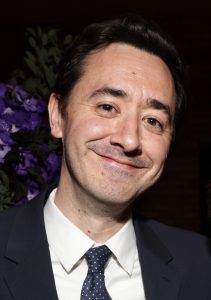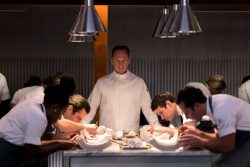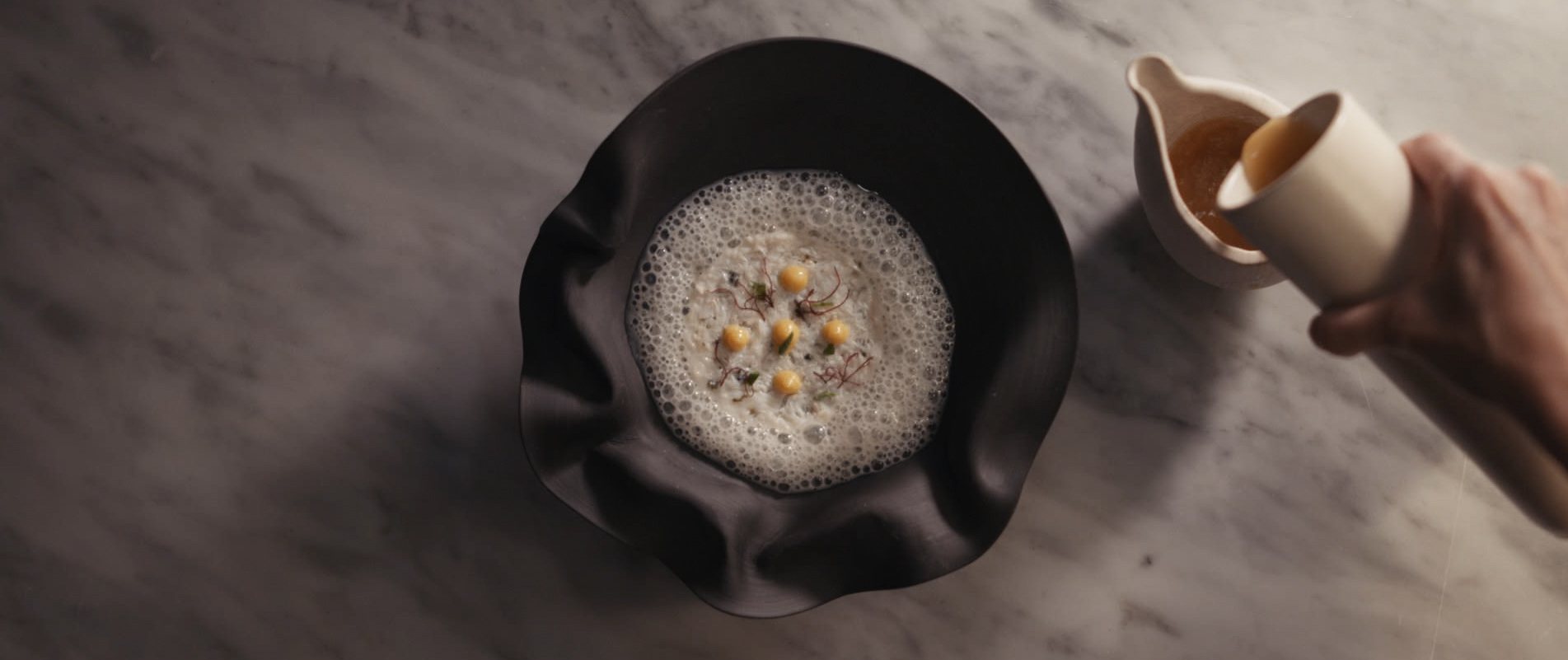“Even before I worked at Late Night With Seth Myers and Will Tracy worked on Last Week Tonight with John Oliver, Will and I wrote for the political satirical website, The Onion together,” said screenwriter Seth Reiss. “Each headline in The Onion creates a world and certain things work as standalone jokes. They’re jokes first and political references second,” he elaborated.
“You can really get away with that when you commit to the verisimilitude of the world whether it’s congress or a restaurant,” added co-writer Will Tracy. Their first job was to fully understand how the restaurant world works so the audience would come onboard and invest in the ride. This laid the ground work for their edgy take on the fine dining scene in The Menu.

Seth Reiss
Like many stories, The Menu was rooted in an experience Will Tracy had that stuck with him. He once took a boat to an island to eat at an exclusive restaurant while he was visiting Bergen, Norway some years ago. As they sat down to eat as it was getting dark, Tracy saw their boat leave. “It was a small island. And I realized, ‘Oh, we’re stuck here for four hours. What if something goes wrong?’” This ignited Tracy’s fear of being trapped in a claustrophobic situation he couldn’t easily extricate himself from. “I have an active imagination and like to feel that whenever I’m in a situation with some ceremony to it, especially if there’s a hushed atmosphere and pressure there, I’d like to feel that I could get up and leave,” continued Tracy. This tonal undercurrent of being trapped infused itself into the feeling in The Menu.
It was the job of the chef and restaurant staff to allay Tracy’s fears so he could enjoy his meal and distract him from the worries of his life. “Some part of my creative brain thought that these feelings of anxiety could make a good story.”
The Genre Triangle
The Menu combines elements of comedy and thriller into a unique genre mix. “Our director Mark Mylod might say it’s a triangle of horror, thriller, and comedy,” added Reiss. “He [Mylod] had to make it an equilateral triangle so it would all work.” Team Reiss-Tracy didn’t over-intellectualize the process. “We just wrote according to our natural inclinations and where the characters took us,” Reiss continued. “We didn’t really wrestle with it,” said Tracy. The genre triangle was galvanized in the edit suite. “We played with to what degree the audience would be horrified and to what degree would they be amused.” That said, the writers confessed that the element of absurdism might divide audience as to when they should or should not laugh.
The comedy in The Menu is obtuse and subtle. It ranges between dark, deadpan and jokes so muted they could easily be missed. Reiss and Tracy admitted they cast “their comedy net very wide” during their writing. They wrote “jokes” in lower case. There weren’t many laugh out loud moments. “The title cards in the film contained “Jokes” with a capital J,” clarified Seth.

Will Tracy
The razor-sharp comedy is dependent on the specific world to be effective – an exclusive restaurant on a remote island. “It felt natural to have a restaurant that sourced its ingredients hyper-locally,” said Tracy. “It was very much forage-based, but we didn’t want it to feel too rustic,” he continued. “It had a sleek, cold, metallic feel that you get from some modernist restaurants.” It was “rustic modernism.” They used modern equipment and techniques to prepare their unique ingredients into exquisite delicacies.
Meals were served in bite-sized portions and the menu served as a roadmap for the film. “We start with the amuse-bouche to the first lighter course which lead to a heavier meat course which lead to a palate cleanser and dessert,” Reiss continued. Each course signifies a story beat in the story.
The tone walks a narrow tightrope between roasting the entire culinary industry and respecting the craft and meticulous care involved in creating a fine dining experience.
The Hawthorn restaurant is headed by lauded chef Julian Slowik (Ralph Fiennes) in a cult-like environment with unquestioningly obedient staff. They are as focused on his vision as he is. “He’s enamored with the timeless nature of the island, but his ego is in constant contradiction to it,” said Reiss.
The diners comprise an eclectic motley crew – Tyler (Nicholas Hoult) a food lover who’s done a comprehensive background check on everything and his last minute plus one Margot (Anya Taylor-Joy), the food critic Lillian Bloom (Janet McTeer) and her editor Ted (Paul Adelstein), the unspecified celebrity (John Leguizamo), the wealthy couple Richard (Reed Birney) and Anne (Judith Light) who barely speak to each other, and the “expense account” tech bros. “There are certain archetypes you see a lot in exclusive restaurants with appealing comic possibilities,” said Tracy. “It’s a group of very sad people,” continued Seth.
Who Is Chef Slowik?
Chef Julian Slowik is at the top of his game, and lives with the constant anxiety of working at the Hawthorn restaurant which he doesn’t own, putting him at the mercy of his tech bro investors.
“He’s an egomaniac,‘ declared Reiss. “All he can do is maintain a level of insane quality. He can’t improve on it. If he gets worse, it spells certain death.” His biggest fear is losing his passion for cooking. “He’s inordinately concerned with legacy,” added Tracy. “Chef Slowik wants to create a masterpiece that he’ll be remembered for. It’s more than work. It’s art that’s uniquely ephemeral. It’s there one minute and gone the next because the floor doesn’t persist.”
Chef Slowik is part of a frightened nanosecond
Slowik is acutely aware that the culinary landscape is changing dramatically before his eyes, and he may not necessarily make it through to the top-tier of chefs. “He knows that his moment is passing and he’s not going quietly,” continued Tracy.
The Menu plays out as a tragedy because his cherry-picked customers are ultimately not satisfied. “He’s coming to the realization that he only satisfied his own ego and not his customers. He’s transcended the need to please them,” said Tracy. Much like a tortured artist who’s misunderstood by the establishment, Slowik is only doing something pure and elevated for himself and his kitchen. The biting social satire shines through as he wrestles with his artistry being corrupted by the elite clientele.

Chef Slowick (Ralph Fiennes). Photo by Eric Zachanowich
“He’s relinquished control of being a people pleaser.” The story also explores why people enter the service industry – they love serving people and offering high quality service.
The Menu also dabbles in themes of control and entitlement. “We’re so used to the idea of things being produced for us for immediate consumption without considering the person making it,” said Reiss. An occupational hazard of the service industry is that despite your best efforts, you won’t always succeed in satisfying someone. Each diner has something at stake. Tyler’s identity as a culinary aficionado is at stake, the tech bros have a financial investment in Hawthorn at stake.
